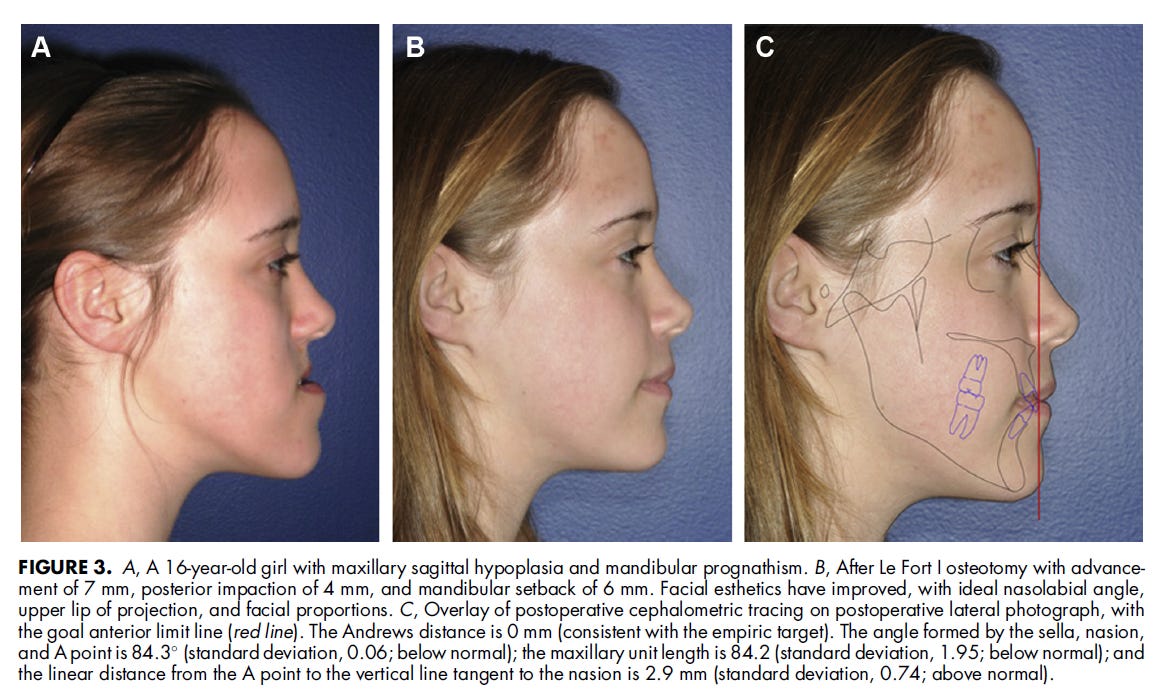Evaluation of Andrews' Analysis as a Predictor of Ideal Sagittal Maxillary Positioning in Orthognathic Surgery
Resnick et al.
Introduction
The study investigates Andrews' Analysis for predicting the ideal sagittal position of the maxilla in orthognathic surgery, focusing on its accuracy in achieving aesthetically pleasing outcomes. Traditionally, sagittal maxillary positioning has relied on cephalometric norms, which may not always yield ideal esthetics due to individual variations. Andrews' Analysis uses forehead position as a reference, hypothesizing that this approach might align more consistently with desired esthetic outcomes, particularly in Caucasian populations.
Methodology
Study Design and Population:
This retrospective cohort study reviewed patients who underwent bimaxillary orthognathic surgery (Le Fort I osteotomy and bilateral sagittal split osteotomies) at Massachusetts General Hospital.
Inclusion criteria were specific to Caucasians with acceptable esthetic outcomes and comprehensive pre- and post-treatment records.
Andrews' Analysis Method:
Andrews' Analysis involves using forehead landmarks to define the "Goal Anterior Limit Line" (GALL), which determines where the maxillary incisors should be positioned sagittally.
For each participant, cephalometric and facial analyses were used, including three standard cephalometric measurements (SNA angle, maxillary unit length, and A-N perpendicular distance).
Data Collection and Statistical Approach:
Preoperative and postoperative measurements were converted into z-scores for statistical comparison, with z-scores closer to zero indicating closer adherence to norm values.
Statistical significance was determined using repeated measures ANOVA and post hoc Bonferroni correction.
Key Findings
Effectiveness of Andrews' Analysis:
For female patients, Andrews' Analysis yielded postoperative results that more closely aligned with the GALL than standard cephalometric measurements, demonstrating greater precision in sagittal maxillary positioning.
Among male patients, the McNamara measurement (A-N perpendicular distance) performed slightly better than Andrews' Analysis but was followed closely by Andrews' Analysis, suggesting its effectiveness across genders, though slightly less reliable in males.
Comparisons with Standard Measurements:
SNA Angle: While commonly used, the SNA angle showed less alignment with esthetic outcomes compared to Andrews' Analysis, likely due to variation in skull base anatomy among patients with facial deformities.
Maxillary Unit Length (MUL): The MUL measurement was also less consistent in predicting ideal maxillary positioning, with greater variability in aligning with Andrews' GALL.
A-N Perpendicular Distance: This McNamara measurement showed the strongest correlation with maxillary position, especially in males, supporting its utility alongside Andrews' Analysis.
Gender Differences:
The study observed stronger alignment of Andrews' Analysis with esthetic goals for females, likely due to its original design for adult Caucasian females. Male cases demonstrated closer alignment with McNamara's A-N perpendicular distance, suggesting slight gender-based variations.
Clinical Implications
Enhanced Esthetic Outcome Prediction:
Andrews' Analysis provides a reliable alternative for maxillary positioning in orthognathic surgery, particularly for female patients. It allows surgeons to estimate ideal maxillary position using forehead landmarks, which are less influenced by intraoral variables and deformities affecting cephalometric norms.
Limitations of Traditional Cephalometric Norms:
The study highlights the limitations of traditional cephalometric measurements (SNA, MUL), which are prone to variability due to individual craniofacial differences. Using an external reference, such as the forehead position, may offer more consistent results in achieving esthetic harmony.
Guidance for Male Patients:
Given the slight reduction in accuracy for male patients with Andrews' Analysis, practitioners may consider using McNamara’s A-N perpendicular distance as a complementary measurement. Together, these methods provide a balanced approach to planning for diverse patient profiles.
Utility for Surgical Planning:
Andrews' Analysis could serve as a valuable tool in orthognathic surgical planning, especially when achieving esthetic harmony is a priority. Its alignment with post-surgical esthetic results offers a patient-centered approach to maxillary positioning.
Conclusion
Andrews' Analysis is a valuable predictor of maxillary sagittal positioning for esthetic outcomes in orthognathic surgery, particularly for Caucasian female patients. While other measurements remain essential, incorporating forehead landmarks offers an innovative approach to enhancing esthetic predictability and patient satisfaction in maxillary surgery. This analysis can complement traditional methods, contributing to a holistic approach to facial harmony and esthetics in orthognathic treatment planning.
For female patients, Andrews' Analysis yielded postoperative results that more closely aligned with the GALL than standard cephalometric measurements.
Given the slight reduction in accuracy for male patients with Andrews' Analysis, practitioners may consider using McNamara’s A-N perpendicular distance as a complementary measurement.






